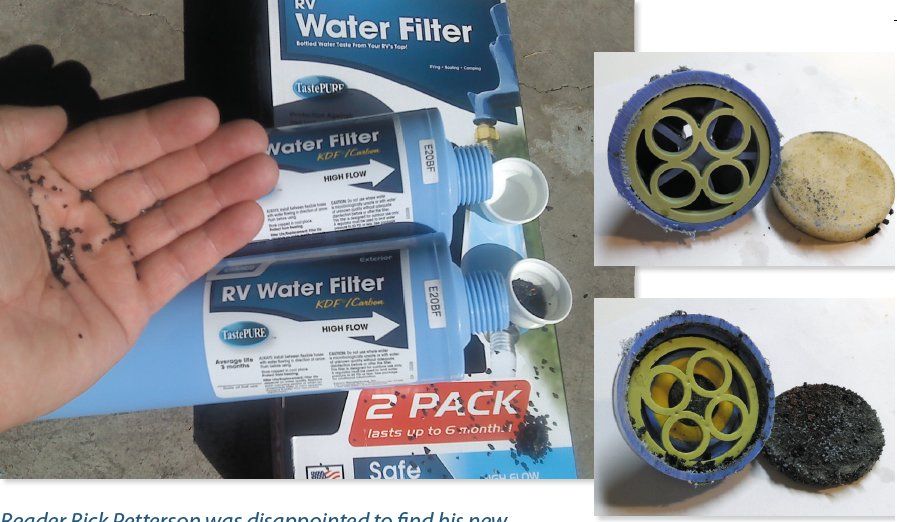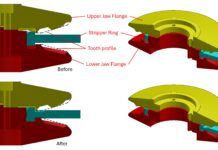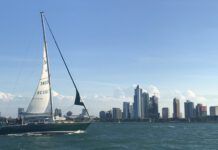
On the recommendation of Practical Sailors water filter test (see PS June 2015), I bought a two pack of Camcos RV Taste Pure water filters through Amazon after finding sediment in my water tank. One of the filters dumped 1/8-cup of the carbon/KDF granuals all over when I took the protective cover off the filter, and it continued to shed the media when I shook the filter. If I had connected the filter to my water supply, it would have contaminated my water system and probably ruined my water pump. Only one of the two filters is dumping carbon/KDF material, so I assumed that this is a product defect.
I contacted Camco, and they said they will replace the filter and may want the bad one back. Camco seems to be stepping up, so lets hope this was a single failure.
Rick Petterson
Kent, Wash.
We cut open the Camco RV filter we were field testing to examine its construction. (See accompanying photos.) It appears that the only way the filter could have leaked granules is if several parts were left out during its construction. After cutting it open, our testers conclusion remains that the Camco RV filter is as well-engineered as more expensive filters.
According to Camco, there have been very few instances of this type of failure in this filter. Camco Sales Manager Wes Vaughn explained, There could have possibly been a defect in the membrane that retains carbon inside the filter. … Its hard to determine without inspecting the actual filter.

I often sail singlehanded or with inexperienced crew. For years, I have used a fannypack-style PFD (see PS Jan. 15, 2005) made by Sospenders when sailing in light or moderate air. This year, I decided to test it out.
The jacket inflated quickly when I pulled the tab, but the plastic pull tab promptly broke into several pieces.I noticed that the inflated horseshoe was rock hard, and getting my head through the hole would be impossible without some deflation of the bag. Also, I wear glasses that stay on when I jump or fall in the water, and I would expect them to still be in place after a fall from the boat. So imagine that one falls suddenly in the water, pulls the PFD tag and the bag inflates like a rock; Id have to partially deflate the bag via the mouth piece tubes, remove my glasses, and then try to get the bag over my head. In the meantime, my boat would have disappeared over the horizon.
One has to really understand the serious limitations of this style of PFD, in my opinion. I am not sure if all are the same, but now I wear a lightweight vest-style, auto-inflation unit.
Michael Horton
A Biendeux, Beneteau First 310
Selby Bay, Edgewater, Md.
Often while working on my sailboat, I am the only person in the marina, and I wonder what I would I do if I fell off the boat since I don’t have a boarding ladder. To that end I am wondering if PS has ever evaluated emergency boarding ladders.
Arnold Rowe
Riverside, Calif.
We last reviewed portable boarding ladders in the December 2002 issue, so its definitely time to revisit the topic. While some of the products we tested for that report are no longer around, testers did find that a few rules of thumb apply to the various types of portable ladders and that proper ladder fit and location will vary from boat to boat. Rules of thumb: You need two full steps below the waters surface, and youll want to consider your stowage space, frequency of use, and type of use. If youre a diver, and your transom allows for it, we recommend mounting a sport ladder bracket. For frequent swimmers, we recommend a stainless-steel latch ladder. If you have a small boat and carry a ladder only for occasional use, try a hook ladder.
Based on your advice in the Exterior Wood Finish Test Two-year Update (see PS September 2011), we chose to apply Pettits Captains 2067 varnish. It has been a challenging experience due to sun and wind, but even more so this time around. After the second coat and it being amazingly hard to sand, I looked at the can again, and to the right of Varnish, it is says its actually a polyurethane. If I had wanted to use a polyurethane, thats what I would have gone shopping for. I will now go back to using Epifanes. Can you tell me why you elected to add it to the test without informing people it really isn’t a varnish?
Dianna Denny
Via email
We apologize for the confusion. These days, varnish is a very general term used to describe a hard wood coating, and it can mean a spar varnish (which uses tung oil-linseed oil) or it can mean a urethane wood coating. We should have included which category each varnish fit into in the Value Guide in that 2011 article. The challenge we face with these years-long evaluations is that we simply do not have the space to include all relevant information and collected data in one article or one table, so we must report them through a series of background articles and performance updates; sometimes, valuable data in the table for the introductory article is omitted to make room for more relevant table data in the performance update, and that was the case here. In that tests launch article (PS August 2007), we discussed varnish types and noted that the Captains 2067 uses a urethane resin. (That article was referenced in the 2011 test report you mentioned.) The two-year test update focused on the performance-test results, so the varnish-type column was omitted to make room for performance data. Going forward with our current round of wood coatings tests (PS June 2015), we will be sure to include varnish type in all tables. With all of our long-term tests, we recommend checking out the previous background and performance reports to ensure you have the whole picture.
Both Epifanes High-gloss and Epifanes Wood finish are spar varnishes, so theyre not as hard as the Captains, but we havent found them to be considerably easier to sand.






































